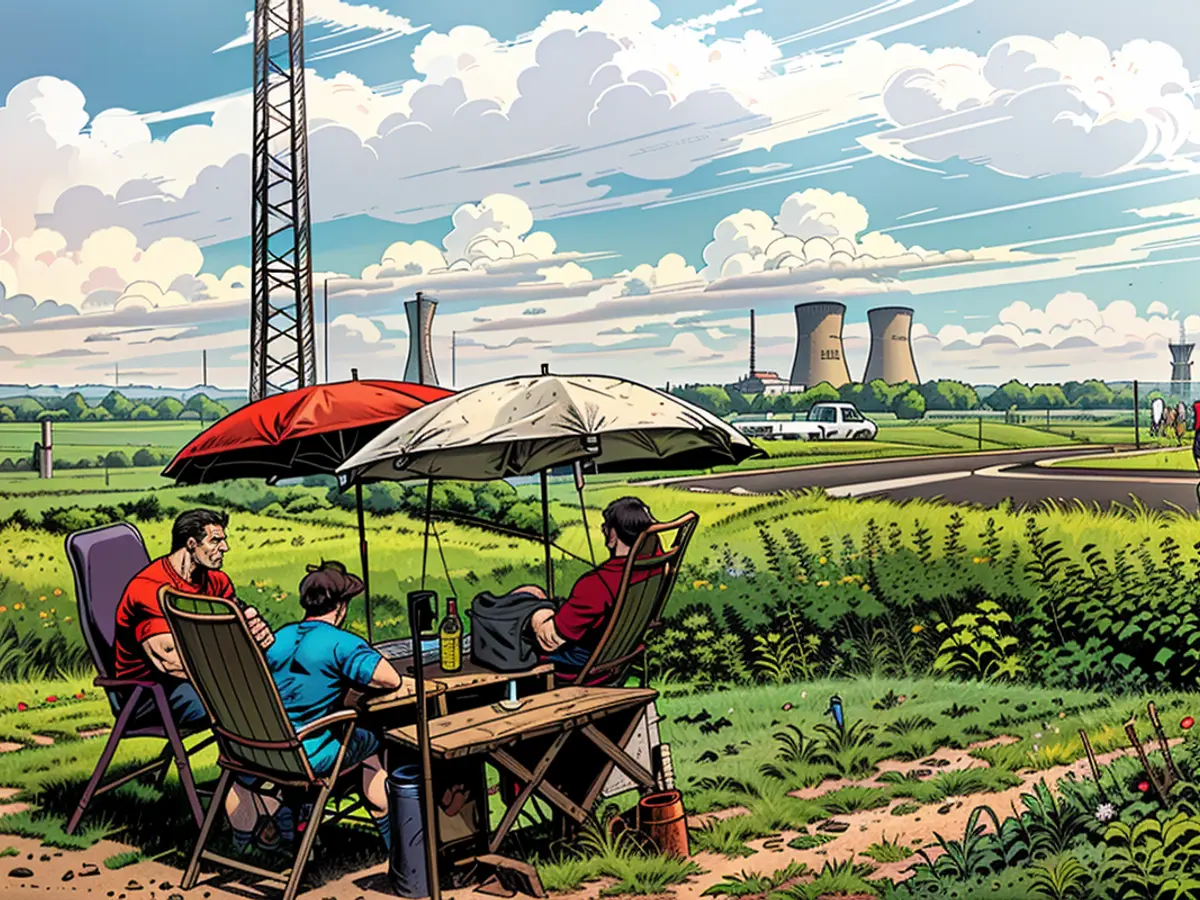- Labels signifying hazardous technology, accumulated waste
"We've always recognized the wind's source by the steam plumes." Acting mayor of Grafenrheinfeld, Christian Keller, born in 1979, has a close relationship with the community, recognizing its iconic nuclear power plant cooling towers. "The twins were a prominent landmark for me and probably many others in the area," Keller reminisced. Kids often asked, "When are we finally home?" and the answer was usually, "Until you see the towers, it's still half an hour," Keller shared. Yet, these landmarks are now a thing of the past.
Loud explosions - and within 30 seconds, the decommissioned nuclear power plant's cooling towers crumbled in the evening. Fifty years since its construction start, all that remained were two small mounds of debris near Schweinfurt.
An unexpected delay in the spectacle occurred due to a man climbing atop a power pole. The police intervened and detained him. The police presumed him to be a nuclear power supporter, with the spokesperson stating, "He will bear substantial costs."
For the demolition of around 34,000 tons of reinforced concrete, metals, and plastics, 1,340 electronic detonators and 260 kg of explosives were required, according to the Schweinfurt district office. The explosion resulted in approximately 50,000 tons of construction waste, mainly concrete. Around 50 firefighters and 200 police officers were present.
Many onlookers watched the event as the towers fell into the evening light, with thousands watching from the meadows and fields surrounding the area near the Main. The area was cordoned off for safety reasons. Those attempting close proximity arrived on foot or by bike, as access roads were closed by the police.
The Jüngling family settled on the other side of the Main near Bergrheinfeld with a picnic setup, including snacks and games. "We mainly play Rommé," said 39-year-old Nicole. Her 11-year-old son was particularly excited, expressing, "I enjoy watching things explode."
The decommissioning process will last another ten years
The nuclear power plant was Germany's oldest active one until its closure. Construction began in 1974. The first chain reaction occurred at the end of 1981 - two years after the birth of the current mayor. Electricity was introduced into the grid from June 1982. It was operational for 33 years until 2015. The decommissioning commenced in 2018 and is expected to continue for another ten years, according to project manager Matthias Aron.
Each tower was 143 meters high. The base diameter was around 105 meters, and at the top, it was 64 meters. "Two-thirds of the material will be reused," Aron explained - a storage area will be established on the site utilizing the building materials.
This was not the first demolition of its kind
According to the power plant operator Preussenelektra, this was the second time in Germany that the cooling towers of a decommissioned nuclear power plant have been demolished. In May 2020, two towers of the nuclear power plant in Baden-Württemberg's Philippsburg were demolished in a similar manner - but without public access due to COVID-19 restrictions.
For the approximately three million euro demolition in Grafenrheinfeld, four of five 380-kilovolt high-voltage lines converging in Grafenrheinfeld and crucial for Europe's power supply had to be shut down to avoid operational disruptions due to excessive dust.
Nuclear waste remains in Grafenrheinfeld without a repository
Even without the towers, the power plant site will remain a security area in the coming years. There are two interim storage facilities for nuclear waste on the site. The planned operating life of the interim storage facility for highly radioactive waste, i.e., nuclear fuel rods, ends in 2046. However, the repository issue remains unresolved - it's about nearly 2,000 containers from all of Germany, which must be safely stored for a million years.
The repository search is a massive project, "which can only succeed if society at large supports it," said Christian Kühn, president of the Federal Office for Nuclear Waste Management (BASE). The Federal Ministry for the Environment assumes that a repository for highly radioactive waste will be found in Germany by 2050, thus 20 years later than initially planned.
Frequently Asked Questions about the Demolition
Informal and simple rephrasing of the given text, keeping the tone, length, and markdown formatting unaltered.
The loss of electricity production became evident as the towers crumbled, their demise requiring 1,340 electronic detonators and 260 kg of explosives. Despite the spectacle, a man trying to support the nuclear power plant was detained by the police.
Recalling the plant's history, the towers were operational for 33 years, producing electricity from 1982 until 2015. Matthias Aron, the project manager, highlighted that two-thirds of the material from the demolition would be reused for a storage area on the site.






